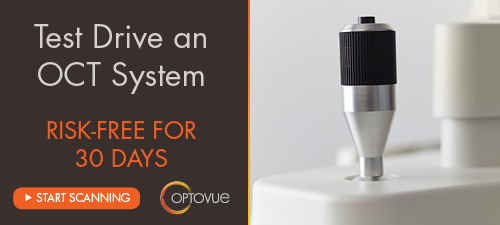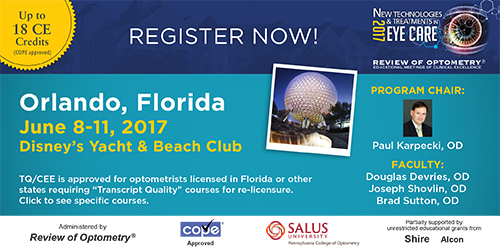
A
weekly e-journal by Art Epstein, OD, FAAO
|
||||||||||||||||||||||||||||||||||||||||||||||
Off the Cuff: Avesis is Latin for We Won’t Be Paying You
As much as I detest health care insurance, some providers are better than others. Then again, some are much worse than others—far worse. Although we hated to lose patients, we sent our notice of withdrawal from the plan and waited to be taken off the provider list. Today, well over a year later, more than a thousand dollars in legitimate claims remain unpaid, despite numerous calls and repeated empty promises. This past weekend, out to dinner with OD friends, we discovered that we’re not alone. A quick check of other local practices shows that this may be endemic.
|
|||||
 |
||
| The Safety of Soft Contact Lenses in Children | ||||
Researchers wrote that there is increasing interest in fitting children with soft contact lenses. They reviewed and collated data from a range of studies to estimate the incidence of complications, specifically corneal infiltrative events and microbial keratitis, in patients under the age of 18 years. Peer-review papers were identified using PubMed and the Web of Science. A broad range of studies are summarized, including large-scale epidemiological studies of contact lens-related complications, hospital-based case series, long- and short-term prospective studies, and multicenter retrospective studies. Nine prospective studies representing 1,800 patient years of wear in 7- to 19-year-olds include safety outcomes. In three large, prospective studies representing between 159 and 723 patient years of soft contact lens wear in patients eight to 14 years, the incidence of corneal infiltrative events is up to 136 per 10,000 years. Data from a large, retrospective study show similar rates of corneal infiltrative events: 97 per 10,000 years in 8- to 12-year-olds (based on 411 patient years of wear) and 335 per 10,000 years in 13- to 17-year-olds (based on 1,372 patient years of wear). None of the prospective studies reported any cases of microbial keratitis. Five clinical studies where safety data were not reported constituted a further 493 patient years. One retrospective study found no cases of microbial keratitis occurred in 8- to 12-year-olds (411 patient years) and an incidence of 15 per 10,000 patient years in 13- to 17-year-olds (1,372 patient years)—no higher than the incidence of microbial keratitis in adults wearing soft contact lenses on an overnight basis. Researchers concluded that the incidence of corneal infiltrative events in children was no higher than in adults, and in the youngest age range of 8 to 11 years, it might be markedly lower. |
||||
SOURCE: Bullimore MA. The safety of soft contact lenses in children. Optom Vis Sci. 2017 May 16. [Epub ahead of print]. |
||||
 |
||
| Scleral Topography Analyzed by Optical Coherence Tomography | ||||
Investigators wrote that a detailed evaluation of the corneo-scleral-profile (CSP) is of particular relevance in soft and scleral lenses fitting. As such, they used optical coherence tomography (OCT) to analyze the profile of the limbal sclera and evaluate the relationship between central corneal radii, corneal eccentricity and scleral radii. Using OCT (Optos OCT/SLO, Dunfermline, Scotland, UK), the limbal scleral radii (SR) of 30 subjects (11M, 19F; mean age 23.8D ± 2.0SD years) were measured in eight meridians 45 degrees apart. Central corneal radii (CR) and corneal eccentricity (CE) were evaluated using the Oculus Keratograph 4 (Oculus, Wetzlar, Germany). Differences between SR in the meridians, and the associations between SR and corneal topography were assessed. Median SR measured along 45 degrees (58.0; interquartile range, 46.8mm to 84.8mm) was significantly flatter than along 0 degrees (30.7; 24.5mm to 44.3mm), 135 degrees (28.4; 24.9mm to 30.9mm), 180 degrees (23.40; 21.3mm to 25.4mm), 225 degrees (25.8; 22.4mm to 32.4mm), 270 degrees (28.8; 25.3mm to 33.1mm), 315 degrees (30.0; 25.0mm to 36.9mm) and 90 degrees (37.1; 29.1mm to 43.4mm). In addition, the nasal SR along 0 degrees were significant flatter than the temporal SR along 180 degrees. Central corneal radius in the flat meridian (7.83 mm ± 0.26mm) and in the steep meridian (7.65mm ± 0.26mm) did not correlate with SR. There was no statistically significant correlation between corneal eccentricity and scleral radii in each meridian. With the OCT device used in this study, investigators were able to measure scleral radii in eight different meridians. They determined that scleral radii were independent of corneal topography and might provide additional data useful in fitting soft and scleral contact lenses. |
||||
SOURCE: Bandlitz S, Bäumer J, Conrad U, et al. Scleral topography analysed by optical coherence tomography. Cont Lens Anterior Eye. 2017 May 8. [Epub ahead of print]. |
||||
|
|||
| Progression of High Anisometropia in Children | ||||
A retrospective study investigated the onset and rate of progression of high anisometropia in myopic children. Children younger than 13 years with anisometropia, myopia of more than 4.00D in the more ametropic eye and a difference in spherical equivalent refraction of 4.00D between both eyes were included. All children had a complete ophthalmologic examination, including measurement of visual acuity and cycloplegic refraction every three to six months for at least five years. Change in the spherical equivalent and the cylindrical error for both eyes, and changes in the difference in spherical equivalent refraction between both eyes were calculated for each patient at each visit. Linear, polynomial, logarithmic and exponential fitting models were tested for both eyes and for the anisometropic difference between both eyes. The regression line with the greatest R2 value was considered the best fit. Sixty-three patients fulfilled the inclusion criteria. The more ametropic eye grew in a regular fashion during the first two years of life, followed by a rapid decrease in the rate of growth to almost stable levels after four years of age. The increase in myopia best fit a third-degree polynomial (cubic) model (R2=0.98). The less ametropic eye showed only a small increase in myopia during the follow-up period. The anisometropic difference between both eyes increased gradually during the first two years, then remained stable. Investigators concluded that high anisometropic myopia progressed rapidly in the first few years of life before becoming stable. |
||||
SOURCE: Zedan RH, El-Fayoumi D, Awadein A. Progression of high anisometropia in children. J Pediatr Ophthalmol Strabismus. 2017;15:1-5. |
||||
 |
||
| News & Notes | |||||||||
| Reichert Introduces Family of Digital Acuity Systems Reichert Technologies launched three ClearChart digital acuity systems: the 4 Digital Acuity System, 4X Enhanced Digital Acuity System and 4P Polarized Digital Acuity System. The new family of ClearChart digital acuity systems offers a wide selection of optotypes and other special test charts. Optotypes include: 17 letter set, 8 letter set, Sloan, HOTV, Landolt C, Landolt C & O, Tumbling E and Children’s Optotypes, among others. Special test charts include astigmatic testing, fusion, phoria and binocular balance. Optotypes can be isolated, increased or decreased in size, and displayed in LogMar, Snellen or linear progression. The systems feature 24-inch, high-resolution, LED-backlit displays that are lightweight and cool running. The systems, which require no separate components or software, are free of moving parts, noisy fans and spinning hard drives. They can be configured for standard or mirrored viewing to accommodate refracting distances from 6 feet to 24.6 feet. Users can import images and videos by importing files from a USB drive. Read more.
|
|||||||||
| Aerie Announces FDA Rhopressa NDA Acceptance & New Hires Aerie Pharmaceuticals received notification from the U.S. Food and Drug Administration that the FDA determined its new drug application for Rhopressa (netarsudil ophthalmic solution) 0.02% is sufficiently complete to permit a substantive review. The Prescription Drug User Fee Act goal date for completing the review is February 28, 2018. The FDA has not identified any potential review issues, and is planning to hold an advisory committee. Read more. Aerie also appointed Jessica Crespo, CPA, as director of accounting, Minh Lu as director of supply chain and Lorcan O’Toole as operations director for the Aerie plant in Athlone, Ireland. Read more. |
|||||||||
| AAOF Names William C. Ezell Fellows The American Academy of Optometry Foundation released the names of recipients of the 2017 William C. Ezell Fellowship program, which is named after the founding president of the AAOF. To date, over 300 of the fellowships have been awarded since the program’s inception in 1949. Funding is provided by leading optometric companies, private endowments and industry partners. This year’s fellows will be honored at the AAOF’s Annual Celebration Luncheon on Oct. 14, during the American Academy of Optometry’s Annual Meeting in Chicago. Here are the 2017-2018 Ezell Fellows: • American Academy of Optometry Ezell Fellow Maria A. Walker, OD, FAAO University of Houston College of Optometry • American Academy of Optometry Foundation Karla Zadnik Ezell Fellow Katherine M. Bickle, OD, MS, FAAO The Ohio State University College of Optometry •AAO Section on Cornea, Contact Lenses and Refractive Technologies Ezell Fellow Erin Rueff, OD, MS, FAAO The Ohio State University College of Optometry • Baycross Christian Family Foundation Binocular Vision and Pediatrics Ezell Fellow Ann Morrison, OD, MS The Ohio State University College of Optometry • Irvin M. Borish – Essilor Ezell Fellow Ian Erkelens, OD University of Waterloo School of Optometry and Vision Science • Mike Daley – Essilor Ezell Fellow Suraj Upadhyaya, OD, FAAO University of Houston College of Optometry • Merton C. Flom Leadership Ezell Fellow Phillip Thomas Yuhas, OD, MS, FAAO The Ohio State University College of Optometry • Michael G. Harris Ezell Fellow Elise N. Harb, OD, MSc, FAAO University of California Berkeley School of Optometry • Optometric Glaucoma Society Ezell Fellow Nevin W. El-Nimri, OD, MS, FAAO University of California Berkeley School of Optometry • John H. Schoen Ezell Fellow Kevin Thomas Willeford, OD, MS, FAAO State University of New York College of Optometry • William C. Ezell Fellow sponsored by Vision Impact Institute Kaitlyn Anne Sapoznik, OD Indiana University School of Optometry |
|||||||||
| Paragon Expands Practice Management Training Paragon Vision Sciences announced the appointment of Jon Hudson, ABOC, NCLEC, to the position of practice management consultant. Prior to joining Paragon Vision Sciences, Hudson served as an optometric consultant to Maui Jim, while providing optometric management counsel to multiple optometric practices within Arizona. He is certified by the American Board of Opticianry and National Contact Lens Examiners. Read more. |
|||||||||
|
|||||||||
|
Optometric Physician™ (OP) newsletter is owned and published by Dr. Arthur Epstein. It is distributed by the Review Group, a Division of Jobson Medical Information LLC (JMI), 11 Campus Boulevard, Newtown Square, PA 19073. HOW TO ADVERTISE |




